[I wrote these notes by hand in a small notebook, typed them up when we got home, and I’m now editing them into blog entries.]
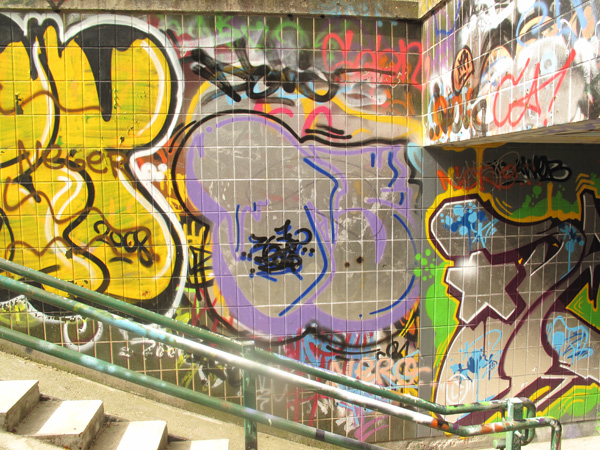
June 18, 2009.
Københaven means “buy” plus “harbor.”
We just ate a big breakfast at the Kong Arthur Hotel buffet. Great stuff. The eggs and butter from this green glove of a peninsula in the North/Baltic seas. From the name, I’d thought maybe the hotel was Chinese-run, but it turns out “kong” means “king” in Danish.
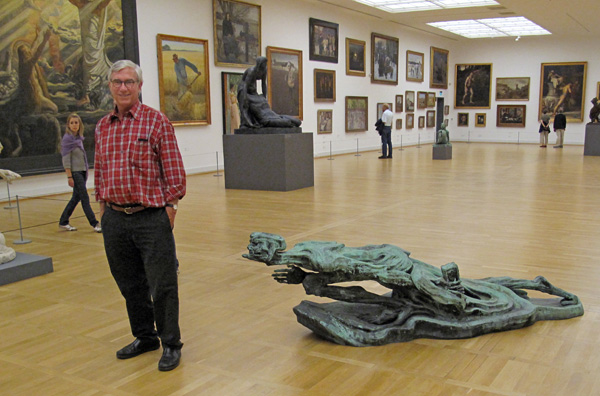
[Death at my heels in the State Museum of Art. I’m glad I beat him to Scandinavia.]
It’s raining, that’s okay. We have raincoats. The best thing I saw yesterday—we got into town at four in the afternoon local time—was four men my age playing jazz in a cobblestone square—sax, bass, a vocalist with a banjo, and a percussion geezer—with people walking through or sitting at cafe tables with coffee, wine, soda, ice-cream—and the old guy playing percussion, with drum sticks, was using his…bicycle as his drum kit, ting-ting on the handlebars, a more resonant konk from the crossbar, thip-thip from the seat. The musicians looked so happy, with the honeyed flow of the music like the sun itself, like time—and for a minute there, still dragging my roller-suitcase and burdened with my knapsack (overfilled with last-minute additions like extra shoes and a second camera), for a minute, I say, or maybe for just thirty seconds, we got our first moment of respite after the twenty hours of the trip.
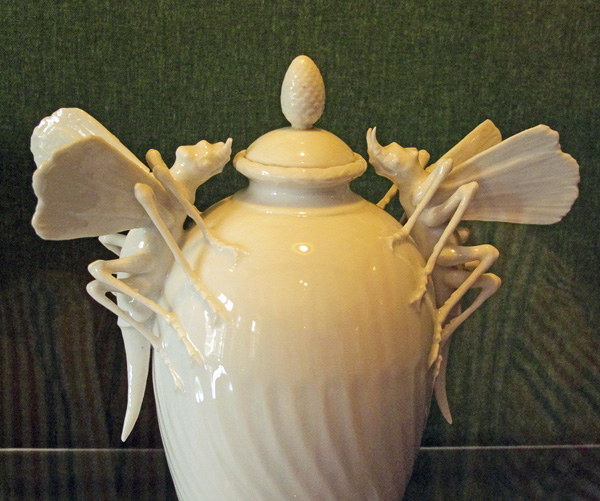
[Art Nouveau porcelain in the The Danish Museum of Art & Design]
We went to bed at 7:30 last night and slept till 4:30 and then I couldn’t go back to sleep. It was already light outside. I read an SF story in Hartwell and Kramer’s The Years’ Best SF #14, it’s good for me to read these annuals, they remind me of what the commercial SF story market is like—I tend to forget or lose track. I liked “Boojum” by Elizabeth Bear and Sarah Monette. I’d kind of forgotten about this kind of SF—people in a crew on a spaceship. A clever tale, the ship is a living being.
I myself balk at writing a story with a “Captain” of a ship, as I so completely lack sympathy for that kind of social hierarchy. I prefer to write stories about loners, or small groups of equals instead. This said, the heroine in “Boojum” is a loner of sorts, and quite likable.
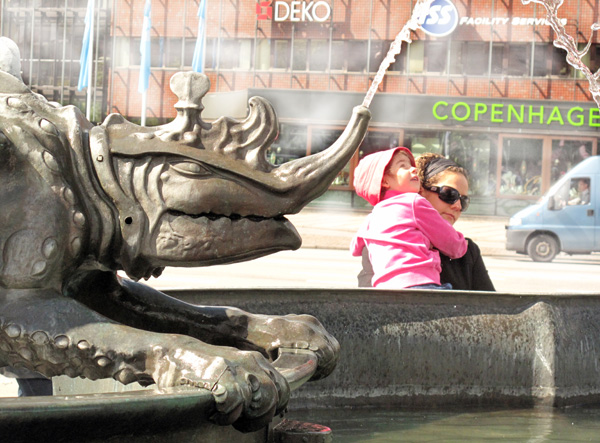
[Monster on a fountain in the Town Hall square.]
I don’t think I’ve ever written about mechaincal spaceships—I don’t believe in them, I guess, any more than in wooden sailing ships that float the the stars. In Frek and the Elixir they ride in an alien living being that’s effectively a UFO, and in Hylozoic there’s a living spaceship as well, a flying manta ray. In Saucer Wisdom some of my people mutate enough to become thick-skinned “spacebugs” who can fly on their own through space. So the “Boojum” story with its living spaceship feels natural to me.
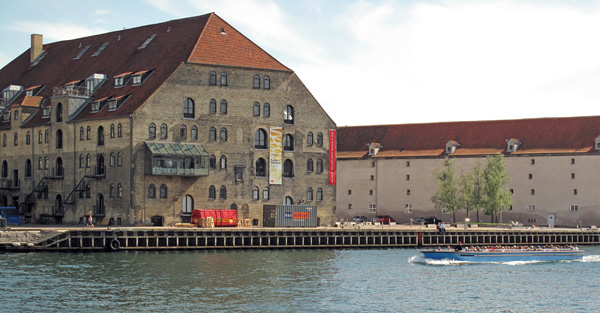
We looked around town today, beautiful. Pale blue sky with fluffy clouds, a Vermeer View of Delft sky. Windy—we’re in a flat country in the sea. We went on a scenic barge cruise and saw a steeple-like tower on the old stock exchange building. The tower has four dragons with their tails twined to the top. The dragons “protected” Copenhagen from fire. On the top of the steeple are three crowns: Dansk, Norsk, and Svensk.
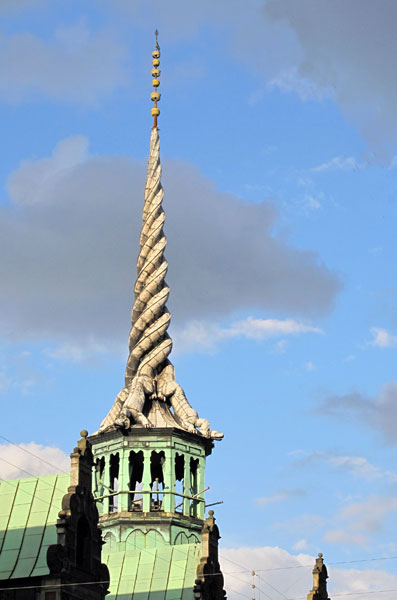
I’d read of Denmark’s “herring bars,” akin to salad bars—a buffet with six or even dozens of kinds of pickled herring. So today I finally had a round of herring bar for about twenty-five bucks. The herring was fishier and less appetizing than I’d dreamed, and I didn’t eat as much as I would have been allowed to. But it was exciting anyway. Everyone’s being very friendly.
The churches are quite Protestant: no stained glass, no colorful paintings, although there is gilding and some white stone statues. A Danish sculptor, Thorvaldson, made life-size sculptures of all the apostles and disciples. How weird it would be to limit your artistic output to so narrow and conventional a range of motifs.
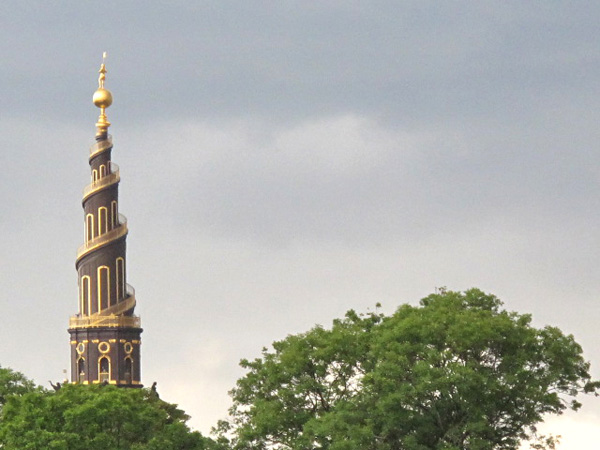
[The spiral tower of the Our Savior Church in Copenhagen. You (not me) can walk up the outside.]
Traditional SF is in some ways like religious art—in the sense of repeatedly treating a small and fixed number of themes, themes which encode certain notions of how the world should be. For that matter, I myself keep returning to a small set of themes and situations—most often the misfit loner who travels to another world.
Maybe it wouldn’t be so bad to write a space crew-member story, and turn it to my own ends by having the character give space travel to the people—either by (a) perfecting individual spacebug travel, (b) teleportation, or (c) finding some (seemingly) friendly aliens who act as personal UFOs.
Call these aliens “gubbers.” My hero(ine) has been warned away from the gubbers by the authorities. In fact the gubbers do exact some individual (or social) cost (like the Hrull in Hylozoic), but the hero(ine) finds a way for individuals to gubberize themselves without having to take recourse to help from those shifty aliens.
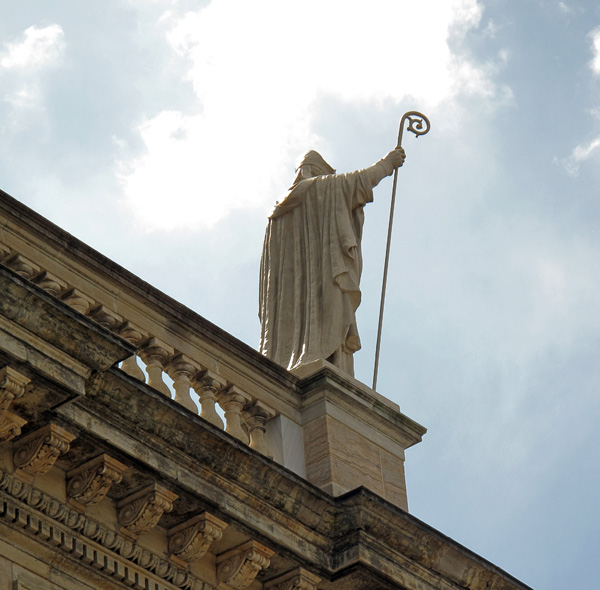
June 19, 2000.
Today I went for a walk with a local fan of my science writing—a media artist named Mogens Jacobsen and his media art curator friend Morten Søndergaard .
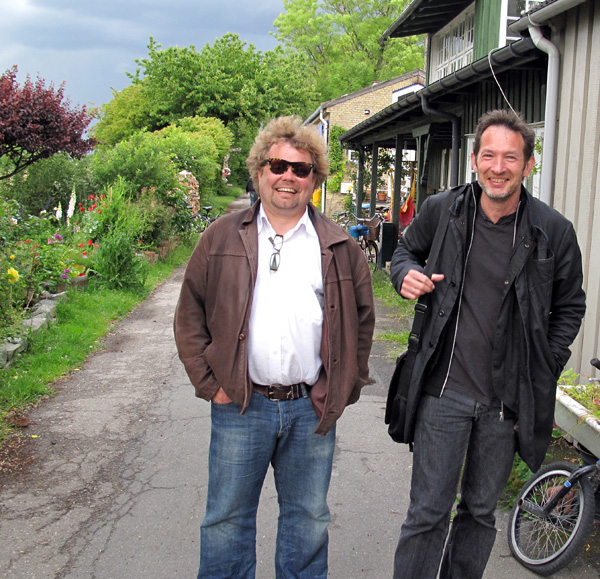
[Morten on the left, Mogens on the right.]
Mogens is a likeable, reserved man. He once made a vinyl record turntable attached to a desktop computer so that people on the web could remotely move the tone-arm of the record player. Currently he’s making five art videos to e shown in a high-end Danish shopping mall. I was amazed to hear this, imagining the weird and transgressive videos that artists might be likely to contribute. And for a mall?
“Can you film a man having sex with a barnyard pig?” I half-seriously asked Mogens, trying to get a feel for the parameters of his task.
“Well, I don’t work with pigs,” Mogens demurred, smiling.
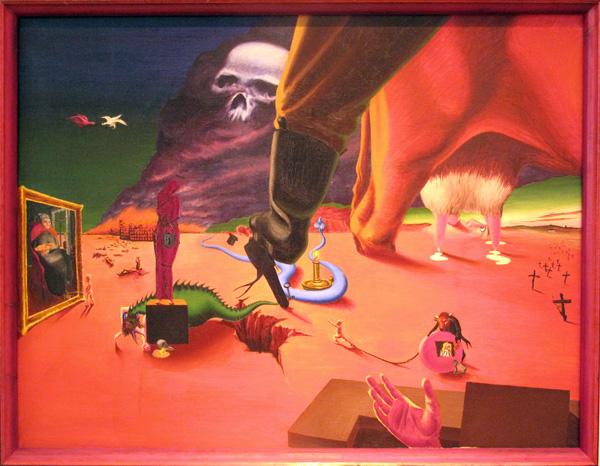
[Painting probably by the Daliesque Danish surrealist painter Wilhelm Freddie]
Mogens and Morten showed me a “free town” neighborhood called Christiania. We took a water taxi across the harbor, and entered Christiania from a marshy area that felt like the countryside—ponds, reeds, trees, a barn or two, gravel roads. We started seeing small houses, brightly colored, some with fanciful roofs. Since the ‘60s or ‘70s, people have been settling in this formerly deserted area, seemingly with a minimum of red tape such as deeds and building codes. I got the impression that many of them are potheads.
We passed to kids on bicycles who were gently and sympathetically leading a staggering-drunk woman away from the roadside where she’d passed out, taking her towards the village center, presumably to her room. It wasn’t like the US at all—you hardly ever see individuals helping or even touching a street person at home. Instead we call in the “authorities.”
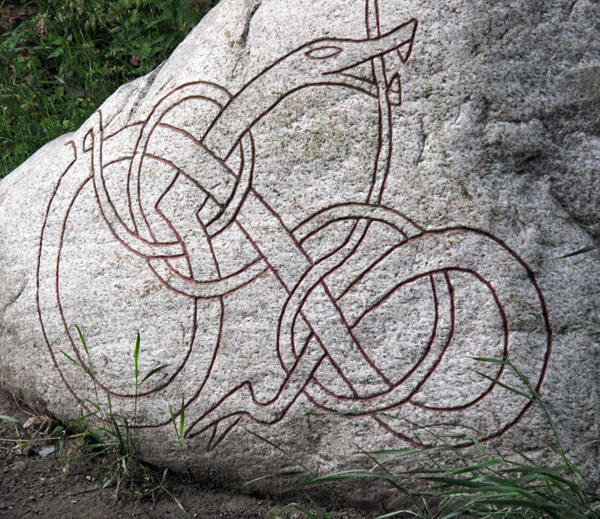
[A rune on a rock in Christiania.]
The gravel roads and pathways of Christiania were immaculately clean—no litter, and none of the broken glass you’d see back home. I marveled at this, and Mogens said, “We maintain a certain level of order on our own.” “That’s something we can’t do in America,” I said ruefully.
There’s some friction with the Danish police in any case. The Christiania cafe had a sign saying something like “This is the safest cafe in Copenhagen, we’ve had 6,000 police raids since 1974.”
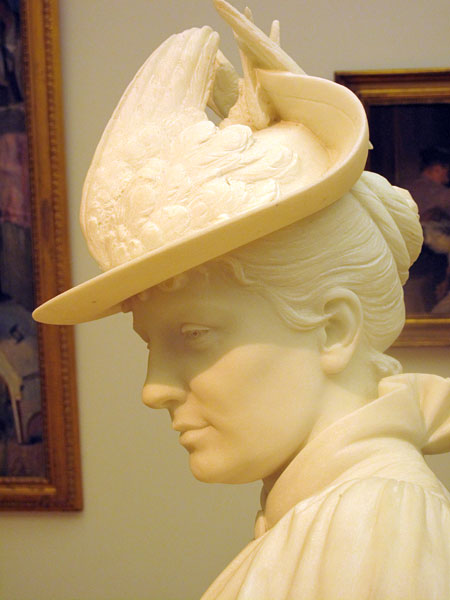
A sudden rainstorm hit and we stood under some eaves. A guy near us was smoking a blunt. Nearby someone was playing AC/DC—they band was slated to give a concert at a soccer stadium in town that night.
“Are you ready to rock and roll?” I screeched in my Angus voice.
“I find it a little bit exhilarating,” remarked Morten,” That we are walking the exact same route as Søren Kierkegaard used to take in the 1840s, in Christiania. The very same philosopher who called himself a ‘fly on Hegel’s nose.’”
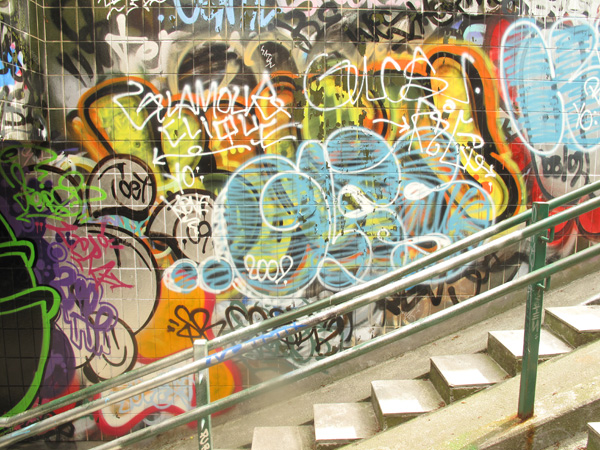









July 7th, 2009 at 12:16 am
Christiania looks and sounds like a wonderful place.
More photos please.
Teep.
Almost finished Hylozoic. Another masterpiece,
in fact it’s weird multiplied by wonderful and then
raised to the power of magnificent masterpiece!
Teep. I love that word…
July 7th, 2009 at 2:34 am
Rudy, how did the question you asked about the man and the pig come about?
Have you read any Denmark authors? There’s one good one I have read. Glad you had a good time.
July 7th, 2009 at 6:38 am
Thanks, Alex. And, Dianne, I changed my entry a little to make clear the answer to your question…basically I was kidding around, although keenly conscious of just how out-there video art can be.
The best-known Danish author is of course Hans Christian Andersen—thinking about his achievement made me aware of how hard it would be to write a fairy tale like “The Emperor’s New Clothes” which permanently enters the mass unconsciousness of society. Another well-known Danish authors is Karen Blixen, who wrote as Isak Dinesen, known for “Out of Africa,” and “Babette’s Feast.”
July 7th, 2009 at 10:48 am
Yes, more pictures please!
Any idea who the sculpture in the second pic is by? Also the the bug urn and fountain, and why are they similar?
I was going to comment that the ‘metal egg’ in “The Hollow Earth” (which I just read) was a mechanical spaceship, but since it was non-functioning and didn’t go into space I guess it doesn’t qualify. Anyhow the book was lots of fun -as is everything of yours that I’ve read so far.
July 7th, 2009 at 4:12 pm
James, I don’t know the names of those artists you asked about, perhaps someone reading this blog can supply them. Or if you did a great deal of Googling you could eventually find it out yourself. Here in any case is a better picture of that sculpture of death, which I find kind of amusing.
You have a point that the “fried egg” shape in THE HOLLOW EARTH is a mechanical-seeming spaceship. And in my story “Inertia,” two guys drive a specially equipped car into space. So I guess I can write about mechanical spaceships. But, realistically, I think we’d want any long-haul ship to be in some sense alive so that it could repair itself. This should be possible within a century or two from now. Biology, after all, is the true nanotech.
July 9th, 2009 at 9:37 am
Rudy, Peter Hoeg is the Danish author I read who is really good. Love the photos of Copenhagen and thanks so much for sharing your thoughts about the place and the photos. Wonderfully interesting and excellent all the way around! 🙂
July 9th, 2009 at 9:39 am
P.S. Love the artwork in the hotel room and also what artwork in it’s various forms you’ve shown here is also extremely interesting! Thanks for sharing! 🙂